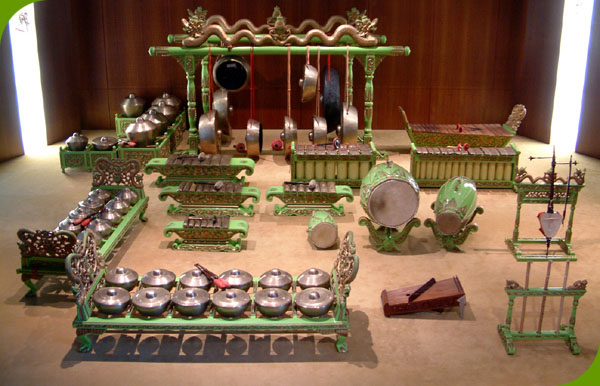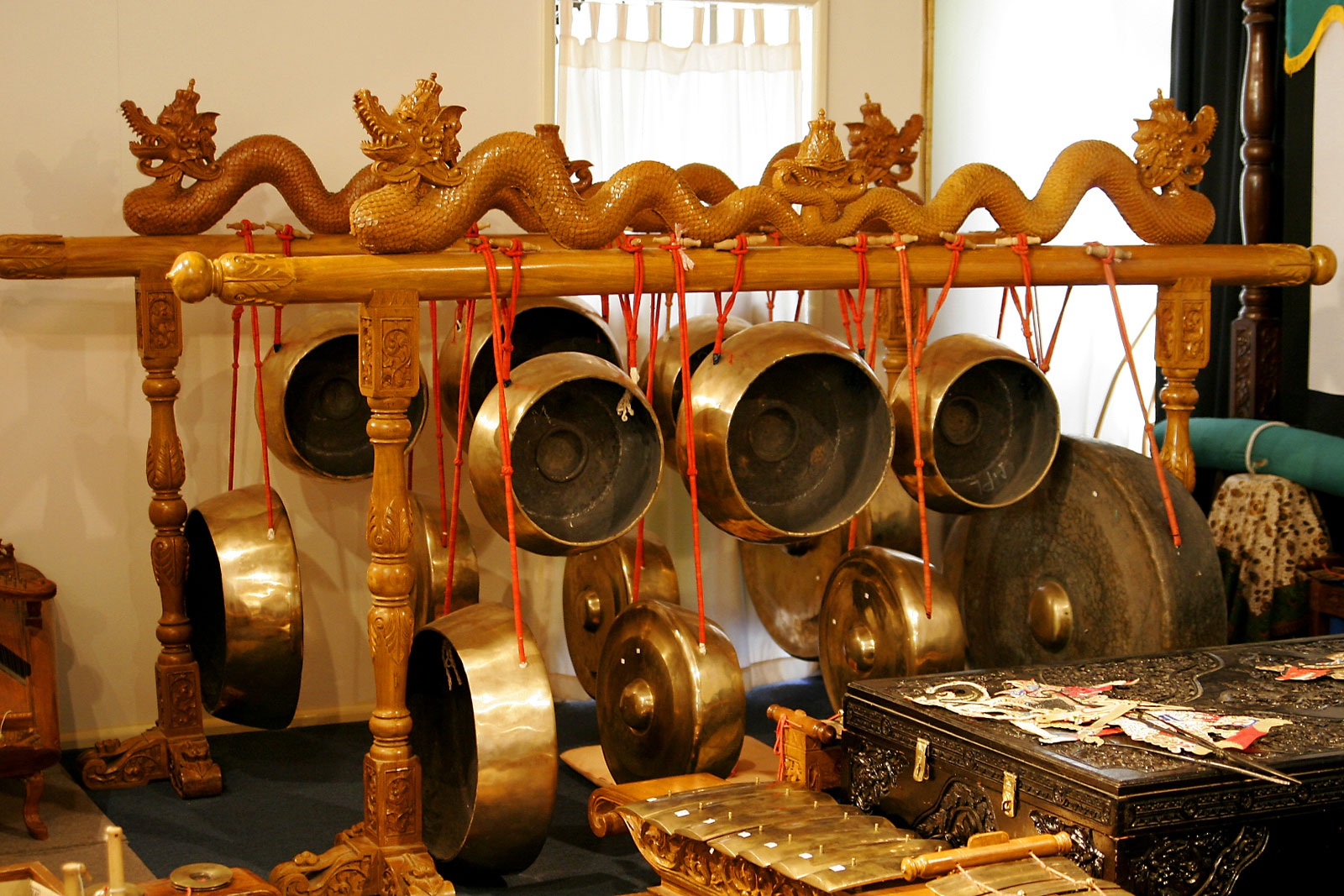Music of Indonesia
 The musics of Java, Sumatra, Bali, Flores and other islands have been documented and recorded, and research by Indonesian and international scholars is ongoing. The music in Indonesia predates historical records, various Native Indonesian tribes often incorporate chants and songs accompanied with musics instruments in their rituals. Today the contemporary music of Indonesia is popular in the region, including neighboring countries; Malaysia, Singapore and Brunei.
The musics of Java, Sumatra, Bali, Flores and other islands have been documented and recorded, and research by Indonesian and international scholars is ongoing. The music in Indonesia predates historical records, various Native Indonesian tribes often incorporate chants and songs accompanied with musics instruments in their rituals. Today the contemporary music of Indonesia is popular in the region, including neighboring countries; Malaysia, Singapore and Brunei.The musical identity of Indonesia as we know it today began as the Bronze Age culture migrated to the Indonesian archipelago in the 2nd-3rd century BC. Traditional musics of Indonesian tribes often uses percussion instruments, especially gendang and gongs. Some of them developed elaborate and distinctive musical instruments, such as sasando string instrument of Rote island, angklung of Sundanese people, and the complex and sophisticated gamelan orchestra of Java and Bali.
 The most popular and famous form of Indonesian music is probably gamelan, an ensemble of tuned percussion instruments that include metallophones, drums, gongs and spike fiddles along with bamboo flutes. Similar ensembles are prevalent throughout Indonesia and Malaysia, however gamelan is originated from Java, Bali, and Lombok.
The most popular and famous form of Indonesian music is probably gamelan, an ensemble of tuned percussion instruments that include metallophones, drums, gongs and spike fiddles along with bamboo flutes. Similar ensembles are prevalent throughout Indonesia and Malaysia, however gamelan is originated from Java, Bali, and Lombok.In Central Java, gamelan is intricate and meticulously laid out. The central melody is played on a metallophone in the center of the orchestra, while the front elaboration and ornamentation on the melody, and, at the back, the gongs slowly punctuate the music. There are two tuning systems. Each Gamelan is tuned to itself, and the intervals between notes on the scale vary between ensembles. The metallophones cover four octaves, and include types like the slenthem, demung, saron panerus and balungan. The soul of the gamelan is believed to reside in the large gong, or gong ageng. Other gongs are tuned to each note of the scale and include ketuk, kenong and kempul. The front section of the orchestra is diverse, and includes rebab, suling, siter, bonang and gambang. Male choruses and female (pesindhen) solo vocalists are common.
With the arrival of the Dutch colonizers, a number system called kepatihan was developed to record the music. Music and dance at the time was divided into several styles based on the main courts in the area â€" Surakarta, Yogyakarta, Pakualaman and Mangkunegaran.
Gamelan from eastern Java is less well-known than central or western parts of the island. Perhaps most distinctive of the area is the extremely large gamyak drum. In West Java, formerly Sunda, has several types of gamelan. Gamelan Degung, gamelan salendro and tembang sunda are three primary types. The Osing Javanese minority in eastern Java are known for social music for weddings and other celebrations, called gandrung, as well as angklung, played by young amateur boys, which is very similar to Balinese gamelan.
Kecapi suling is a type of instrumental music that is highly improvisational and popular in parts of West Java that employs two instruments, kecapi and suling (bamboo flute). It is related to tembang sunda.
Angklung is a bamboo musical instrument native to Sundanese people of West Java. It is made out of bamboo tubes attached to a bamboo frame. The tubes are carved so that they have a distinctive resonant pitch when being vibrated. Each angklung only plays one note.
Kolintang or kulintang is a bronze and wooden percussion instrument native to eastern Indonesia and also The Philippines. In Indonesia it is particularly associated with Minahasa people of North Sulawesi, however it also popular in Maluku and Timor.
Sasando is a plucked string instrument native of Rote island of East Nusa Tenggara. The parts of sasando are a bamboo cylinder surrounded by several wedges where the strings are stretched, surrounded by a bag-like fan of dried lontar or palmyra leafs, functioned as the resonator of the instrument.
Musical performance from Tapanuli area of Batak of North Sumatra. Tapanuli ogong is a form of dance music played with a type of lute, trumpet and flute.
The diverse world of Indonesian music genres was the result of the musical creativity of its people, and also the subsequent cultural encounters with foreign musical influences into the archipelago. Next to distinctive native form of musics, several genres can traces its origin to foreign influences; such as gambus and qasidah from Middle Eastern Islamic music, keroncong from Portuguese influences, and dangdut with notable Hindi music influence.
Indonesian regional folk pop musics reflects the diversity of Indonesian culture and Indonesian ethnicity, mostly use local languages and a mix of western and regional style music and instruments. Indonesian folk music is quite diverse, and today embraces pop, rock, house, hip hop and other genres, as well as distinct Indonesian forms. There are several kinds of "ethnic" pop music, generally grouped together as Pop Daerah. These include Pop sunda, Pop Minang, Pop Batak, Pop Melayu, Pop Ambon, Pop Minahasa and others. Other than featuring the legacy of Lagu Daerah (regional traditional songs) of each regional cultures, the musician might also create some new compositions in their own native language.
The contemporary form of Islamic Middle eastern influenced musics in Indonesia is Debu, that featuring sufism approach on music to spread their message.
Perhaps the most famous song in the kroncong style is Bengawan Solo, written in 1940 by Gesang Martohartono, a Solonese musician. Written during the Japanese Imperial Army occupation of the island in World War II, the song became widely popular among the Javanese, and then later nationally when recordings were broadcast over the local radio stations. The song also became quite popular with the Japanese soldiers, and when they returned to Japan at the end of the war re-recordings of it (by Japanese artists) became best-sellers. Over the years it has been re-released many times by notable artists, mainly within Asia but also beyond (like Anneke Grxnloh), and in some places it is seen as typifying Indonesian music. Gesang himself remains the most renowned exponent of the style, which although it is seen now as a somewhat starchy and "dated" form is still popular among large segments of the population, particularly the older generation.
After the World War II and during Indonesian National Revolution and afterwards, kroncong was associated with patriotism, since many of Indonesian poets and patriotic songs authors uses kroncong and somewhat jazz fusion as the genre of their works. The patriotic theme and romantic wartime romance was obvious in the works of Ismail Marzuki, such as Rayuan Pulau Kelapa, Indonesia Pusaka, Sepasang Mata Bola, Keroncong Serenata and Juwita Malam. These patriotic songs can be sung in hymn or even in orchestra, but most often was sung in kroncong style known as kroncong perjuangan (struggle kroncong). The kroncong divas; Waldjinah, Sundari Sukoco and Hetty Koes Endang, was instrumental in reviving the style in the 1980s.
There is a style of kroncong native to Surakarta called langgam jawa, which fuses kroncong with the gamelan seven-note scale.
Early in the 20th century, kroncong was used in a type of theater called Komedi Stambul; adapted for this purpose, the music was called gambang kromong. Gambang kromong is quite prevalent in Betawi culture of Jakarta.
Dangdut is based around the singers, and stars include Rhoma Irama and Elvy Sukaesih, Mansyur S., A. Rafiq, Camelia Malik and Fahmy Shahab; along with Cici Paramida, Evie Tamala, Inul Daratista, Julia Perez and Dewi Perssik from younger generation.
A musical fusion style of traditional Javanese music and dangdut that prevalent in Javanese cultural sphere, mainly Central Java, Yogyakarta and East Java. There is also Sundanese version of campursari prevalent in Bandung region of West Java. Perhaps its greatest current artist is Didi Kempot.
The contemporary music of Indonesia is diverse and vibrant. Throughout its history, Indonesian musicians were open to foreign influences of various music genres of the world. American jazz were heavily marketed in Asia, and foxtrots, tangos, rumbas, blues and Hawaiian guitar styles were all imitated by Indonesian musicians. As the result various genres were developed within Indonesian music frame; Indonesian pop, rock, jazz, and hip hop.
Indonesian music also plays a vital role in the Indonesian creative pop culture, especially as the soundtracks or theme songs of Indonesian cinema and sinetrons. Indonesian popular film Badai Pasti Berlalu (1977) were also produced successful soundtrack hit with same title in the same year, the soundtrack was remaked in 1999 with Chrisye as the main singer and rendered by Erwin Gutawa in orchestra style. In 2007 the film also being remaked again with new soundtrack that still featuring same songs performed by younger generation artist. Another popular Indonesian coming of age teen movie Ada Apa Dengan Cinta (2002) also produced successful soundtrack hits with most songs written and performed by Melly Goeslaw.
Today Indonesian music industry enjoyed nationwide popularity. Thanks to common culture and intelligible languages between Indonesian and Malay, Indonesian music enjoyed regional popularity in neighbouring countries such as Malaysia, Singapore and Brunei. However the overwhelming popularity of Indonesian music in Malaysia had alarmed the Malaysian music industry. In 2008 Malaysian music industry demanded the restriction of Indonesian songs on Malaysian radio broadcasts.
Related Sites for Music of Indonesia
- Amazon.com: Indonesia: Music read Music of Indonesia
- Amazon.com: Indonesia: Music read Music of Indonesia
- Music of Indonesia read Music of Indonesia
- Indonesia music - Listen free at Last.fm read Music of Indonesia

No comments:
Post a Comment